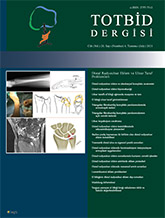
Lunotriquetral (LT) joint disorders are among the reasons of ulnar side pain. At examination of LT joint, tenderness and stability should be checked. Additionally, provocative tests should be performed. In these tests, the presence of movement between the lunate and triquetrum is evaluated. Magnetic resonance imaging (MRI) may not always provide sufficient findings to evaluate the LT joint. While MR arthrography, dynamic radiographic examinations and kinematic computed tomography (CT) examinations are helpful in diagnosis; arthroscopy is the gold standard for diagnosis. Ligament ruptures of the LT joint progress to Volar Intercalated Segmental Instability (VISI) in chronic period. VISI is becoming of scaphoid and lunate to more flexed and triquetrum to more extended position. Planning of the treatment varies according to whether LT joint disorder is acute or chronic, traumatic, or degenerative, and the presence of perilunate instability or carpal collapse. Surgical options are arthroscopic or open LT debridement, repair or reconstruction of LT ligament, dorsal ligament capsulodesis and LT joint arthrodesis.